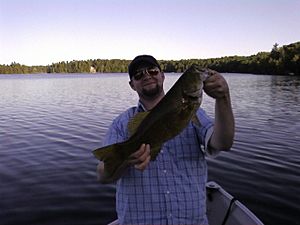Smallmouth bass facts for kids
Quick facts for kids Smallmouth bass |
|
|---|---|
 |
|
| Conservation status | |
| Scientific classification | |
| Kingdom: | |
| Phylum: | |
| Class: | |
| Order: | |
| Family: | |
| Genus: | |
| Species: |
M. dolomieu
|
| Binomial name | |
| Micropterus dolomieu Lacépède, 1802
|
|
The smallmouth bass (Micropterus dolomieu) is a type of freshwater fish. It is part of the sunfish family called Centrarchidae. This fish is a very popular game fish for anglers (people who fish) across North America. Smallmouth bass have been moved to many cool lakes and rivers in Canada and the United States. They are originally from the upper and middle Mississippi River basin, the Saint Lawrence River–Great Lakes system, and the Hudson Bay basin. Some common names for this fish are smallmouth, bronzeback, brown bass, and smallie.
Contents
What Does a Smallmouth Bass Look Like?
Smallmouth bass are usually brown, but sometimes they can be yellow. They have red eyes and dark brown stripes on their bodies. Their upper jaw reaches about the middle of their eye.
- Males are usually smaller than females.
- Males often weigh around two pounds (about 1 kg).
- Females can weigh from three to six pounds (about 1.4 to 2.7 kg).
The size of a smallmouth bass can depend on where it lives. Fish in warmer places, like the United States, tend to grow larger. This is because they have longer summers to eat and grow. Their habitat also affects their color and shape.
- Smallmouth bass living in dark rivers are often dark brown and shaped like a torpedo.
- Those living in sandy parts of lakes are usually light yellow-brown and more oval-shaped.
Where Do Smallmouth Bass Live?
Smallmouth bass like clearer water than their cousin, the Largemouth bass. They especially like streams and rivers. They also prefer rocky areas, stumps, and sandy bottoms of lakes and reservoirs. Smallmouth bass prefer cooler water temperatures than largemouth bass. They can live in both still water and moving water.
Because they do not like pollution, smallmouth bass are a good sign of a healthy environment. They are carnivores, meaning they eat other animals. Their diet includes crayfish, insects, and smaller fish. Young smallmouth bass, called fry, eat tiny water creatures called zooplankton. However, they will also eat their smaller siblings if they are hungry!
Smallmouth Bass Reproduction
The female smallmouth bass lays many eggs. She can lay from 1,000 to 6,000 eggs for every pound of her body weight. The male bass builds a nest, usually in deeper water than a largemouth bass's nest. He then guards the nest. He will chase off the female after she lays her eggs so other females can lay their eggs in his nest. The eggs hatch into fry in about one or two days, depending on how warm the water is. After hatching, the fry quickly leave the nest area and are on their own.
Fishing for Smallmouth Bass
Smallmouth bass were first introduced to new areas in the United States when the Erie Canal was built in 1825. This helped them spread into central New York state. In the 1800s, smallmouth bass were moved by train to lakes and rivers across the northern and western United States, even as far as California. People found that smallmouth bass were tough fish that could survive being moved in buckets or barrels on trains.
Over time, many eastern trout rivers became polluted or filled with dirt, making the water too warm for native trout. Smallmouth bass were often put into these rivers because they could handle the warmer water. They became a popular fish for anglers. They also spread to large, cool-water lakes and reservoirs.
Later, smallmouth bass numbers started to drop because of pollution and the loss of their river homes. This happened when many wild rivers were dammed to create lakes. In recent years, people have worked hard to keep water clean and protect river habitat. These efforts have helped smallmouth bass populations grow again. This has made them even more popular with fishermen.
Today, smallmouth bass are very popular game fish. They are known as one of the toughest fighting freshwater fish in North America. Many fishermen enjoy catching them using different types of fishing gear. Smallmouth bass are also put into cool rivers and lakes across Canada and the United States to help their populations. When hooked, smallmouth bass are known for their strong fighting ability, especially near the water's surface. Old fishing books even called them "ounce for ounce and pound for pound the gamest fish that swims."
Some people keep smallmouth bass to eat. Their meat is white and firm when cooked. However, many fishermen today practice catch and release fishing. This means they let the fish go after catching them to help keep fish populations healthy.
The current world record for a smallmouth bass is 11 pounds, 15 ounces (about 5.4 kg). It was caught by David Hayes in the Dale Hollow Reservoir, on the Kentucky/Tennessee border, in 1955.
Fishing Gear for Smallmouth Bass

When fishing for smallmouth bass, anglers can use many different natural and artificial baits or lures.
- Artificial Lures: These include crankbaits, hair jigs, plastic jerkbaits, spinnerbaits, and soft plastic lures like curly tail grubs or tubes with lead head jigs.
- Fly Fishing: You can also catch them with a fly rod using different types of flies. These can be dry or wet flies, nymphs, streamers, or lures that look like bigger water creatures such as hellgrammites, crawfish, or leeches. Floating topwater popper fly patterns and buzz baits are also popular for smallmouth fishing.
For river fishing, spinning gear or fly fishing gear are usually the most popular tools for catching smallmouth bass in North America.
Images for kids







